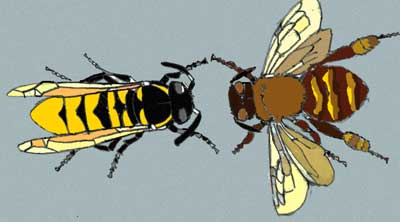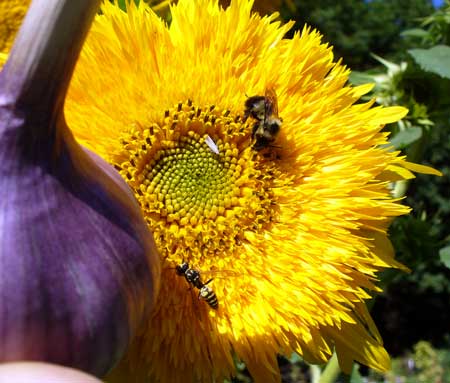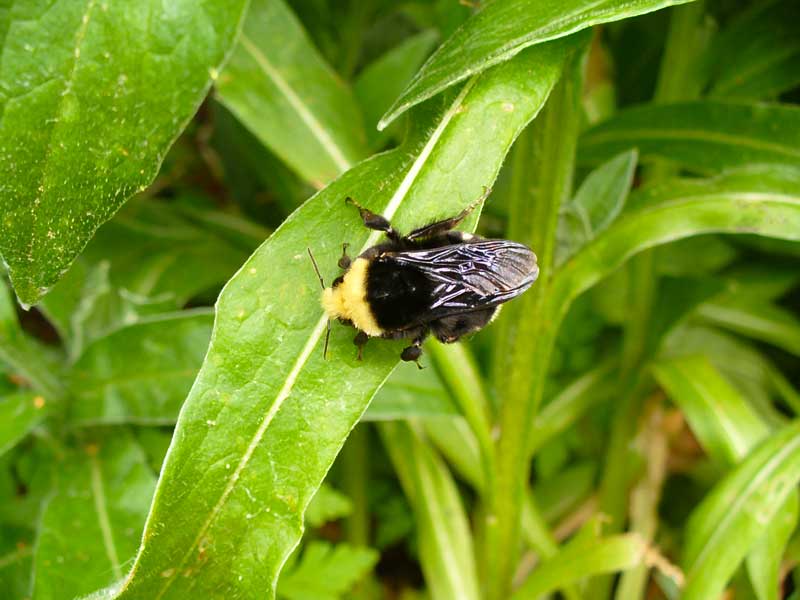How to Tell the Difference Between Bees and Wasps (or Hornet or Yellow Jacket)
Is it a bee or a wasp? Can you tell the difference?
Bees hate to be mistaken for wasps. As far as bees are concerned wasps are the cousins on 'that' side of the family. Wasps give bees a very bad name. This informative page can help you tell them apart.
 Picture: The wasp is on the left while the honeybee is on the right. Bees and wasps come in many sizes and colors but in general wasps are much 'harder looking' with sharp colors and bees are fuzzier looking with softer colors. Wasps may or may not have a slender abdomen or waist (it depends on whether they are fans of physical fitness or not).
Picture: The wasp is on the left while the honeybee is on the right. Bees and wasps come in many sizes and colors but in general wasps are much 'harder looking' with sharp colors and bees are fuzzier looking with softer colors. Wasps may or may not have a slender abdomen or waist (it depends on whether they are fans of physical fitness or not).
Can it Sting You More than Once?
If you sit on it and it stings you more than once it is likely a wasp. Wasps can sting multiple times and are much more aggressive than bees. Wasps will give you the 'stingdown' just for looking at them funny. Honeybees can only sting you once and then they die since their stinger is pulled out. Honeybees normally only sting if they are protecting their nest or if you stomp or sit on them. MOST people are stung by wasps, not bees.
What is it Eating?
 Picture: Bumblebee on top of sunflower with wasp on the bottom of flower. Chesnok Red garlic bulb in foreground (strangely there is garlic in many of my pictures; I find it adds that extra spice).
Picture: Bumblebee on top of sunflower with wasp on the bottom of flower. Chesnok Red garlic bulb in foreground (strangely there is garlic in many of my pictures; I find it adds that extra spice).
Is it peacefully sipping nectar from a flower? Bee. Is it going after your hotdog late in the summer? Wasp. Bees are happy vegetarian pollinators and eat nectar and pollen. Wasps are predators and normally eat insects and your hamburger.
Wasps have a sweet tooth though, and will happily sip your coke ... and than give you a stingdown for trying to get it back. I've known more than one person who got stung on the lip from picking up and drinking from an unattended can of pop with a wasp hidden under the tab.
Where Does it Live?
If it lives in a little paper hive under your eaves it is likely a wasp. If you want to test you can try hitting the hive with a stick to see if a swarm of angry wasps pour out (but only if you can run really, really fast - I don't recommend it.)
Whatever you do don't imitate the numerous YouTube videos about people destroying wasp nest in extremely dangerous ways such as flame, gasoline, bug zappers, paint ball guns, hoses or other methods. Some of them make extremely interesting viewing (see death by hotdog), however, and it is amazing how many people call yellow jackets, wasps or hornets 'bees'. No wonder bees and entomologists are upset about the confusion.
Both bees and wasps can live in a variety of places such as burrows, old trees, plant stems, and in people's houses. For more on where bees live see common bee families of North America.
Is it Cute and Fuzzy or Lean and Mean?
 Picture: A cute and fuzzy bumblebee relaxes on a leaf. At no point in time does she threaten to go cray cray on the photographer.
Picture: A cute and fuzzy bumblebee relaxes on a leaf. At no point in time does she threaten to go cray cray on the photographer.
Is it cute and fuzzy and a little klutzy? Bumblebee. Does it give you honey as it floats from flower to flower? Honeybee. Does it put you in a headlock as it steals your lunch? Wasp. Is your first thought, "Wholly crap that thing is friggin huge" (followed closely by "run")? Hornet, these big boys of the wasp family can be up to 2 inches in the USA and bigger overseas. Do you want to pet it? Bee. Do you want to flame it? Wasp.
In general, wasps are skinnier and shinier than bees. They just look tougher and more streamlined. Bees are covered in fuzzy hair and are much less aggressive acting. Wasp zip. Bees float.
More About Wasps
Wasps will attack and kill bees to feed them to their young. For more about how to protect your beehives check out this website on one beekeeper's experiments to help protect his hive.
Do wasps have a good side? Yes, there are over 100,000 species of wasps. Only a few are the aggressive species that we generally know as wasps, yellow jackets or hornets. They give the rest of the family a bad name. Some species of wasps are parasites that help keep insect populations in check. Other wasps don't even sting! Even the nasty stinging wasps do good work by eating insect pests. I usually try to control aggressive wasps with traps and welcome all other types of wasps.
How I Control Wasps, Yellow Jackets and Hornets
The Safe Way to Control Wasps: I use traps. You can buy wasp traps or make your own out of plastic soda bottles (google 'wasp trap soda bottle' and several kinds come up; here's one type of free wasp trap and here's pictures on how to make another wasp trap from plastic bottles). Traps work great if you put them out early in the season before the wasp season explodes.
My favorite bait to put in the trap is water, fruit or jam, ham or other meat and a little sugar. Other people swear by a combination of water, beer, vinegar and jam. Personally, I have found that the fruit plus ham combo is like crack for wasps and it doesn't seem to catch bees.
Warning: Do not use honey in your trap or bees will be attracted to the honey and you don't want to trap bees. Some people swear that adding vinegar discourages bees but attracts wasps; I have not tried this.)
Only Queen wasps overwinter so it takes a while for the wasp population to build up during the summer. Many people recommend putting out wasp traps in early to mid spring to capture Queen wasps; this severely cuts down on the number of wasps you will have in late summer and early fall. Some people use pheromones to attract queens but they only work of you have the right pheromones for the species you are trying to control.
The Redneck Way To Remove Wasps: My sister and I have also used a vacuum cleaner to suck up yellow jackets from raspberry bushes. This worked very well and got rid of 95% of the foraging yellow jackets in about 3 sessions without poisons or collateral damage to beneficial insects.
My sister's role was to completely cover herself in thick clothes including a hoodie and a scarf over her face. She pointed out any bee or wasp like insect that caught her eye. Occasionally she would squeak and run backwards while flailing her arms due to a close flying bug.
My role was to determine if pointed out insect was wasp, yellow jacket, hornet, robber fly, bee or bumblebee or bee mimic. Suck up wasps, yellow jackets and hornets leaving other species free to roam. I'll admit that this task was made easier by a bit of Redneck blood, a vendetta against pesty hornets that eat those raspberries which I've been weeding all season, a younger brother allergic to stings, and a small gaggle of nieces and nephews susceptible to hornet bites.
Disclaimer: Do not try to vacuum yellow jackets if you are allergic to stings or really scared of wasps. Wasps can sting and bite you repeatedly so always be careful and never go outside your comfort zone due to something crazy you've read or watched on the internet (like a pair of nutty sisters vacuuming up yellow jackets!) Don't try to suck up a wasp nest unless you are sure it will fit in the vacuum cleaner hose.
FYI: Chickens love wasp larvae (just don't give them poisoned wasp nests).
